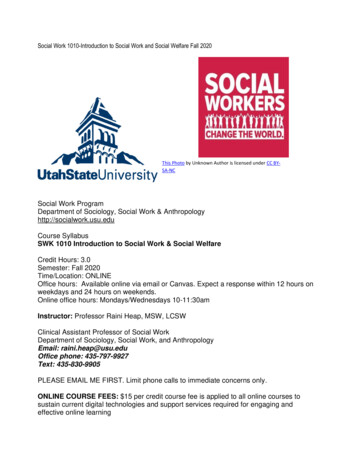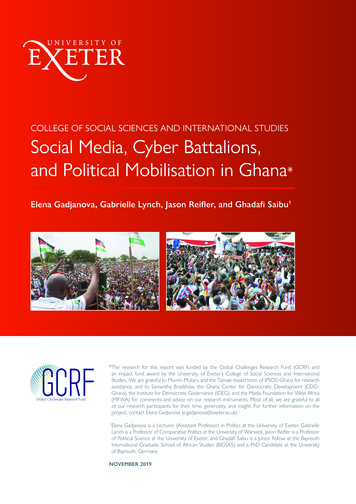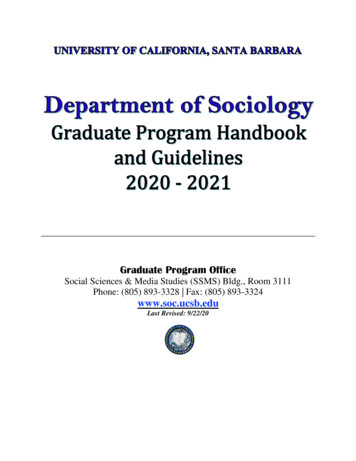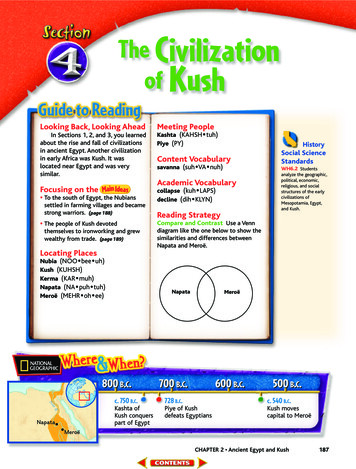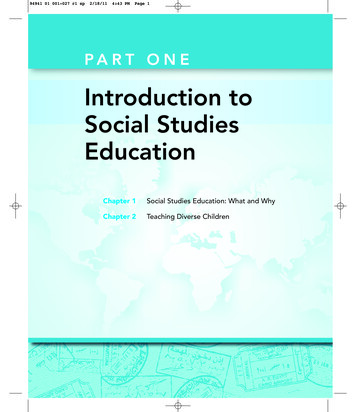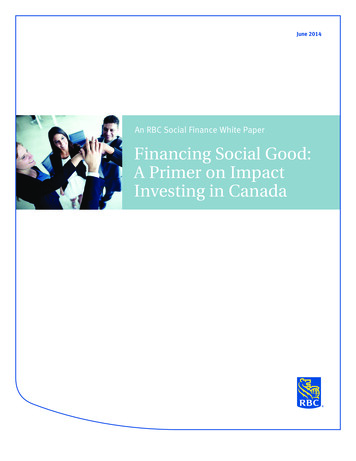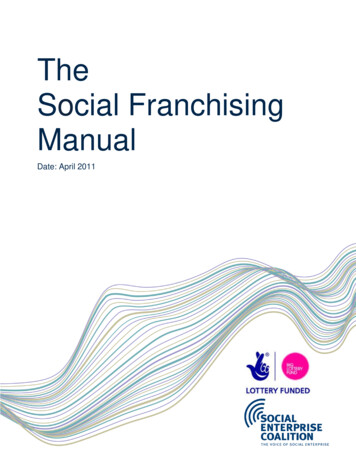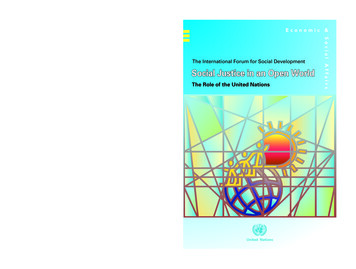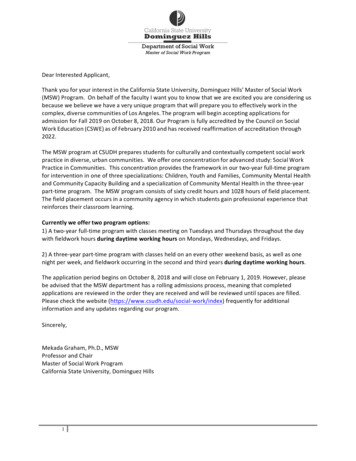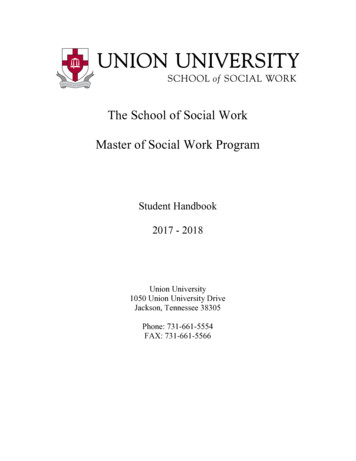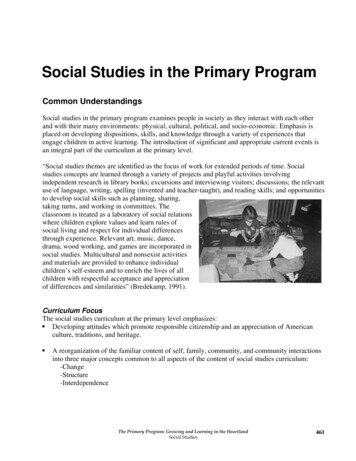
Transcription
Social Studies in the Primary ProgramCommon UnderstandingsSocial studies in the primary program examines people in society as they interact with each otherand with their many environments: physical, cultural, political, and socio-economic. Emphasis isplaced on developing dispositions, skills, and knowledge through a variety of experiences thatengage children in active learning. The introduction of significant and appropriate current events isan integral part of the curriculum at the primary level.“Social studies themes are identified as the focus of work for extended periods of time. Socialstudies concepts are learned through a variety of projects and playful activities involvingindependent research in library books; excursions and interviewing visitors; discussions; the relevantuse of language, writing, spelling (invented and teacher-taught), and reading skills; and opportunitiesto develop social skills such as planning, sharing,taking turns, and working in committees. Theclassroom is treated as a laboratory of social relationswhere children explore values and learn rules ofsocial living and respect for individual differencesthrough experience. Relevant art, music, dance,drama, wood working, and games are incorporated insocial studies. Multicultural and nonsexist activitiesand materials are provided to enhance individualchildren’s self-esteem and to enrich the lives of allchildren with respectful acceptance and appreciationof differences and similarities” (Bredekamp, 1991).Curriculum FocusThe social studies curriculum at the primary level emphasizes: Developing attitudes which promote responsible citizenship and an appreciation of Americanculture, traditions, and heritage. A reorganization of the familiar content of self, family, community, and community interactionsinto three major concepts common to all aspects of the content of social studies curriculum:-Change-Structure-InterdependenceThe Primary Program: Growing and Learning in the HeartlandSocial Studies461
Processes and skills of problem-solving, decision-making, interpreting maps and globes, andlocating, acquiring, organizing, and evaluating information.Each of these is more fully developed under the dimensions of dispositions, skills, and knowledge.Integrating CurriculumSocial studies can be approached by using the familiar content of self, family, community, andinteraction of communities to organize thematic learning experiences that include the developmentof dispositions, skills, and knowledge of the social studies curriculum or the larger concepts ofstructure, interdependence, and change. The teacher can weave the dispositions, skills, andknowledge of social studies into other thematic studies, language experiences, and the child’s dailyinteractions in school and community.The family, school, neighborhood, andcommunity are content-rich workshops invitingexploration and inquiry. They invite children togenerate, locate, acquire, and organizeinformation through field trips and first handexperiences. They also invite children to representknowledge in a variety of ways, in addition tocommunicating and representing orally and inwriting. The content of social studies is also afamiliar theme in many books and poems forprimary children. Through language andliterature, this content and the related concepts canalso be introduced, developed, or expanded.Learning Dimensions Through Social StudiesDispositionsLearning experiences focusing on primary social studies provide children with opportunities to: Develop an interest and curiosity in the world Develop dispositions of responsible citizenship Value and respect similarities and differences among people Value, respect, and appreciate the variety of cultural identities and heritages in America and theworld Respect and care for the environment462The Primary Program: Growing and Learning in the HeartlandSocial Studies
Learning experiences in the primary years providemany opportunities for teachers to help childrendevelop an interest in and curiosity about theworld and to demonstrate responsible behavior inthe family, classroom, school, and community.Positive attitudes toward individuals, cultures, andthe environment contribute to the development ofpersonally and socially responsible people. Suchdispositions, while not unique to social studies, areemphasized here because of their importance forthe young learner. They also illustrate theintegrated nature of curriculum throughout theprimary program.SkillsMany of the skills and processes of social studies are also integral components of other curricularareas. They are outlined here to show the degree of overlap and integration of processes and skills inthe total primary program. For example: Problem-solving and decision-making are important thinking processes. Understanding time and chronology as components of the measurement strand in mathematics. Locating, acquiring, and organizing information through reading, listening, viewing, andcommunicating, both orally and in writing, are all components of language development. Citizenship skills, an integral component of the goals of social and emotional development andthe development of responsibility, are also emphasized in the Responsible Living curriculum.Learning experiences which focus on primary social studies provide children with opportunities to: Participate in problem-solving activities related to social studies content Participate in decision-making activities related to social studies content Interpret maps and globes Locate, organize, acquire, and evaluate information related to social studies content.KnowledgeSocial UnitsA social unit can be defined as a group with members who have an ongoing relationship to oneanother. Examples of social units are the family, school, neighborhood, community, state, andnation. Further examples of social units include the classroom, a factory, an ant hill, a club, apolitical party, a farm, a wolf pack, a zoo, and an orchestra.All of these social units can be studied in terms of structure, interdependence, and change. Theseconcepts form the major organizing principles of the social studies curriculum. These concepts canbe used by the teacher as vehicles to link social studies with other curriculum areas. For example, aThe Primary Program: Growing and Learning in the HeartlandSocial Studies463
study of the farm could include an investigation of its structure, its interdependence, and change,with these discoveries being related to the children’s personal experiences with structure,interdependence, and change within the family, classroom, or community.The examination of social units in the primary years should include a focus on the family,community, state, and the United States, with all learning continually being related to the child’sown experiences.The Importance of SelfYoung children are interested in talking and learning about themselves and their experiences.Through focusing on themselves, children may explore: Uniqueness Personal needs Similarities with others Responsibilities Personal changeAs their social world expands to include other children, young children show more interest insharing and comparing information with their peers. Content in social studies should always includeopportunities for both younger and older primary children to relate what they are learning tothemselves and to their peers.Structure of Social UnitsStructure is anything arranged in a definite pattern or organization: Families can be studied in terms of their structure, size, and composition. Communities have a definite structure: Physical–boundaries, roads, sewer systems, etc. Social–neighborhoods, organizations, friendship patterns Political–government (school, municipal, regional districts). America has a structure: Physical-geography, boundaries Social-national emblems such as the flag and anthem Political-capitals, states, territories Other social units have a structure (for example, beehive): Physical Social (queen bee, drones, worker bees)Children’s study of the organization of their families, communities, and other social units enablethem to recognize similarities and differences while broadening their understanding of theseconcepts. Through contrast and comparison, children’s perspectives for viewing their own familiarsocial units (family, neighborhood, school, community) are broadened.464The Primary Program: Growing and Learning in the HeartlandSocial Studies
The following illustrates how structure might be examined in various social units familiar to thechild:All Families Have StructuresMy FamilyMichael’s FamilyA Bear’s FamilyCinderella’s Family MomDad2 brothers1 sisterGrandmaMeDad1 sisterMom2 cubsStep mother2 step sistersCinderellaThe Interdependence of Social UnitsSocial units interact with one another, satisfy one another’s needs, and have roles andresponsibilities.Families can be studied in terms of the interdependence of their members: The needs of family members: food, shelter, clothing, love, safety, and recreation The roles and responsibilities of family members The interaction of family members: conflict and cooperation, rights and responsibilities,authority, and affectionCommunities can be studied in terms of the interdependence of their members within theircommunities: The roles and responsibilities of community members including workers, volunteers, andcitizens The provision of goods, safety and protection, education, health and social services, recreation,and aesthetic expressions Human interaction within the community including rights and responsibilities, friendship andaffiliation, authority, cooperation, and conflictCommunities can also be studied in terms of their interaction with other communities and with theenvironment: The interaction of American communities through use of resources, government, transportationand communication, education, health and social services, recreation, and cultural expressionOther social units can be studied in terms of interdependence. For example, bees depend upon thebeekeeper and the available flora which in turn is dependent upon climate and soil. These topics canbe thoroughly developed and explored in the primary classroom with the study touching on all areasof the curriculum.The Primary Program: Growing and Learning in the HeartlandSocial Studies465
Change in Social UnitsFamilies may be studied in terms of change in: Membership, location, structure, occupation, roles, and responsibilitiesCommunities may be studied in terms of: The changes in a community over time (historical) Interaction and, change within the physical environment Projected change for the futureOther social units (bees) may be studied in terms of: Changes over time (summer/winter) Interaction (roles)My Community ChangesDuring Fall Corn matures Trees lose leaves Birds, ducks, geese,cranes migrateDuring Winter Snow Ice ColdChange in Social UnitsMy Family’s ActivitiesChange A Deer Family Changes Eat corn left in fieldsMay be huntedMove to wintering area Harvest cornRake leavesPrepare garden forwinterHunt SleddingPlay indoors Sleep in thick, woodedareasLook for foodDuring Spring Warmer weather Rain Wind Plants grow Fly kitesSoftball/baseballPlay outdoorsPlant garden Fawns are bornRoam outdoorsFood is easier to findDuring Summer Heat No school SwimVacation Eat plantsRaise young466The Primary Program: Growing and Learning in the HeartlandSocial Studies
ReferencesBredekamp, S. and Copple, C. (Eds.). (1997). Developmentally appropriate practice in early childhoodprograms serving children from birth through age 8. Expanded edition. Washington, DC: NationalAssociation for the Education of Young Children.ResourcesBorden, E. J. (1987). The Community Connection: It Works! Young Children, 42(4), 14-23.California State Board of Education. (1987). History-social science framework for California public schoolskindergarten through grade twelve. Sacramento, CA: Author.Chapman, C., & Freeman, L. (1996). Multiple intelligences centers and projects. Arlington Heights, IL:IRI/Skylight Training and Publishing.Davies, A., & Politano, C. (1994). Multi-age and more. Winnipeg, MB: Peguis Publishers.Davies, A., & Politano, C. (1993). Making themes work. Winnipeg, MB: Peguis Publishers.Dighe, J. (1993). Children and the earth, Young Children, 48(3), 58-63.Hoot, J. L., & Foster, M. L. (1993). Promoting ecological responsibility through the arts. ChildhoodEducation, 69(3), 150-155.Katz, L. & McClellan, D. (1991). The teacher’s role in the social development of young children. Urbana, IL:ERIC.Kovalik, S. (1993). ITI: The model-integrated thematic instruction. (2nd ed.). Village of Oak Creek, AZ:Books for Educators.Mitchell, A. & David, J. (1992). Explorations with young children: A curriculum guide from the bank streetcollege of education. Mt. Ranier, MD: Gryphon House.National Council for the Social Studies. (1989). Social studies for early childhood and elementary schoolchildren: A report from NCSS task force on early childhood elementary social studies. Social Education,53(1), 14-24.Ryan, F. (1980). The social studies sourcebook. Boston, MA: Allyn & Bacon.Saracho, 0. N., & Spodek, B. (1983). Understanding the multicultural experience in early childhoodeducation. Washington, DC: National Association for the Education of Young Children.Seefeldt, C. (1989). Social studies for the preschool-primary child (2nd ed.) Columbus, OH: Merrill.Seefeldt, C. (1993). Social Studies: Learning for Freedom. Young Children, 48(3), 4-9.Smith C. (1982). Promoting the social development of young children: Strategies and activities. Palo Alto,CA: Mayfield.The Primary Program: Growing and Learning in the HeartlandSocial Studies467
Descriptors of Learning in Social StudiesEarly PrimaryLater PrimaryDispositionsThe child:The child: Recognizes cultural similarities anddifferences Recognizes the ways in which all people arealike Understands that differences in people do notchange the ways in which we are all alike Accepts responsibility for her/his behavior Accepts responsibility for her/his behaviorand anticipates consequences of actions Participates in a wide variety of activities Participates in a wide variety of activities Demonstrates responsible behavior in caringfor the school environment Understands and demonstrates responsiblebehavior with respect to a healthierenvironment Responds with interest to exploration of theschool and community environments Demonstrates an interest in and curiosityabout an expanding world environment468The Primary Program: Growing and Learning in the HeartlandSocial Studies
Descriptors of Learning in Social StudiesEarly PrimaryLater PrimarySkillsThe child:The child: Identifies a problem or issue Identifies possible solutions or answers Locates and acquires information through: Print sources Pictorial sources Real-life interactions Locates and acquires information through: Print sources Pictorial sources Real-life interactions Technology and media sources Organizes information through a variety ofconcrete presentations Organizes information through a variety ofconcrete and symbolic representations atincreasingly complex levels Evaluates whether information is fiction ornon-fiction Evaluates whether information is fact oropinion Compares objects, pictures, and ideas usingconcrete attributes Compares objects, pictures, and ideas using alarger variety of concrete and abstractattributes Locates and represents specific informationon maps and globesThe Primary Program: Growing and Learning in the HeartlandSocial Studies469
Descriptors of Learning in Social StudiesEarly PrimaryLater PrimaryKnowledgeSelf as the Fundamental Social UnitThe child:The child: Identifies own unique characteristics Recognizes similarities and differencesamong people Recognizes own personal needs: physical,emotional, social, and intellectual Understands that all people have similarneedsAccept appropriate responsibility for ownactions Demonstrates ability to interact cooperativelywith othersIdentifies important personal changes:physical, emotional, social, and intellectual Develops the ability to cope with and controlpersonal change Structure of Social UnitsThe child:The child: Investigates various social units Understands connections among varioussocial units Investigates structure of social units Compares and contrasts structures ofdiffering social units470The Primary Program: Growing and Learning in the HeartlandSocial Studies
Descriptors of Learning in Social StudiesEarly PrimaryLater PrimaryKnowledgeInterdependence of Social UnitsThe child:The child: Recognizes that members of a social unitsatisfy one another’s needs Understands that members of a social unithave different degrees of responsibility forsatisfying needs Recognizes that members of a social unithave different roles Compares similarities in roles among socialunitsChange in Social UnitsThe child:The child: Recognizes that all social units change overtime Investigates how social units change, makespredictions about change Recognizes that changes in a social unitaffect its members Recognizes that changes in a social unitaffects its members in different waysThe Primary Program: Growing and Learning in the HeartlandSocial Studies471
472The Primary Program: Growing and Learning in the HeartlandSocial Studies
A social unit can be defined as a group with members who have an ongoing relationship to one another. Examples of social units are the family, school, neighborhood, community, state, and nation. Further examples of social units include the classroom, a factory, an ant hill, a club, a polit
